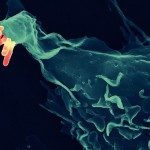Link to Pubmed [PMID] – 33848057
Link to DOI – 10.1111/cmi.13342
Cell Microbiol 2021 Apr; ():
Large volumes of liquid and other material from the extracellular environment are internalized by eukaryotic cells via an endocytic process called macropinocytosis. It is now recognized that this fundamental and evolutionary conserved pathway is hijacked by numerous intracellular pathogens as entry portal to the host cell interior. Yet, an increasing number of additional cellular functions of macropinosomes in pathologic processes have been reported beyond this role for fluid internalization. It emerges that the identity of macropinosomes can vary hugely and change rapidly during their lifetime. A deeper understanding of this important multifaceted compartment is based on novel methods for their investigation. These methods are either imaging-based for the tracking of macropinosome dynamics, or they provide the means to extract macropinosomes at high purity for comprehensive proteomic analyses. Here, we portray these new approaches for the investigation of macropinosomes. We document how these method developments have provided insights for a new understanding of the intracellular lifestyle of the bacterial pathogens Shigella and Salmonella. We suggest that a systematic complete characterization of macropinosome subversion with these approaches during other infection processes and pathologies will be highly beneficial for our understanding of the underlying cellular and molecular processes. This article is protected by copyright. All rights reserved.

